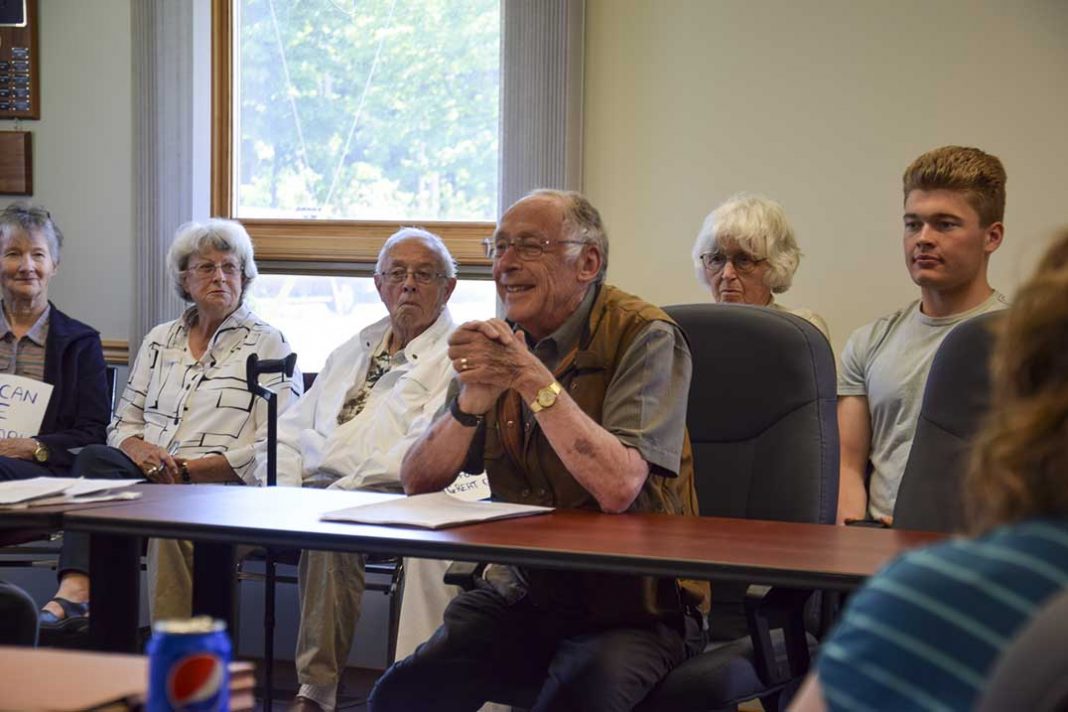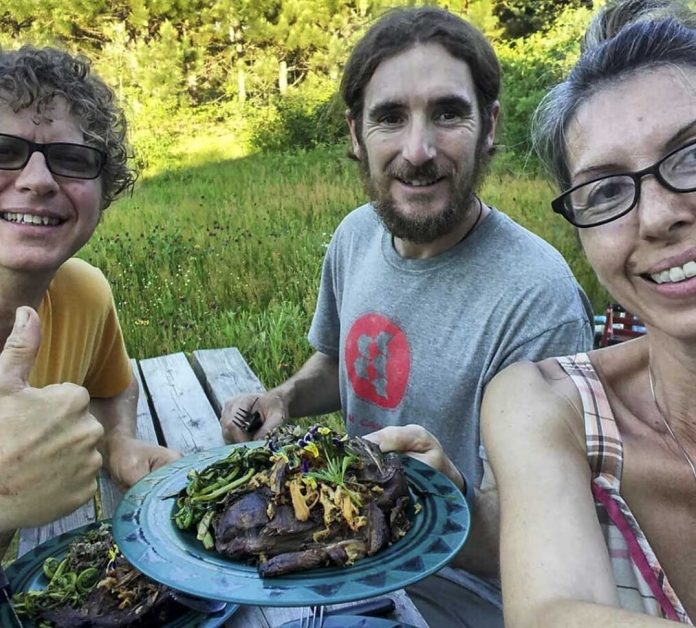CENTRAL MANITOULIN – Citing the previous sale of portions of Wagg’s Wood Park to commercial interests and decades of alleged neglect, supporters of the green space voiced support for turning over the park property to the Escarpment Biosphere Conservancy in order to protect it for future generations. A local businessperson who purchased part of the park provided the lone voice speaking against the proposal.
The Central Manitoulin council chambers was packed to overflowing for the office and administration committee meeting where Escarpment Biosphere Conservancy Executive Director Bob Barnett presented the EBC proposal and offered responses to council member’s concerns. In addition to Mr. Barnett, local environmentalist Jan McQuay and Wagg family representative Gail Meehan presented to the committee in support of the proposal. Island businessman Wayne Legge presented a dissenting view.
Mr. Barnett began his presentation by outlining the important role that nature plays in the provincial economy, citing a Ministry of Natural Resources and Forestry report that concluded that nature contributes $85 billion a year to the Ontario economy “south of the Shield,” which technically includes Manitoulin.
“This contribution includes protection from flooding, carbon sequestration, cleaner air, water, more pollinators and many other factors including tourism and protection of rare species,” he said. “Nature contributes $1.8 billion to the economy of the Greenbelt through outdoor activities alone.”
Moreover, nature is good for health and education “and is less expensive than doctors, schools, teachers and hospitals,” he said. “Hundreds of doctors are prescribing getting out into nature for better health. That’s why we do what we do,” said Mr. Barnett in explaining the rationale for the work of the EBC. “We think protecting nature is a good thing.”
Mr. Barnett explained the role of the 40 land trusts in the province, which together protect 90,000 acres province-wide, nearly as much as the province itself. Still, he noted, “development outstrips conservation by 300 acres a day, 432 square kilometres a year.”
The EBC executive director went on to note that the EBC is a federally regulated charity run by local directors, including two from Manitoulin Island, and is responsible for 170 conservation reserves encompassing 54 square kilometres, many of which are smaller in size than the Wagg’s Wood property.
The EBC’s interest in protecting the Wagg’s Wood property, he noted, is that the property includes escarpment outcrops, has a stream running through it, is the only forested park area in the municipality and is home to important species such as wood thrush.
As a significant bonus from the economic point of view, the park is located “right in Mindemoya, contributing tourism dollars to local business.”
In his proposal to the municipality, Mr. Barnett pointed out that the EBC would take on legal and liability responsibility, would maintain and build the trails system as they have the popular Cup and Saucer trail in the Northeast Town, would provide an easement on title to ensure the town has complete access to the stream to prevent flooding. He noted that the EBC has only objected to nearby development once in its history, that being when a gravel quarry proposed digging below the water table that would have drained an EBC protected wetland.
Further, should the EBC ever fail (an unlikely proposition given its ongoing success, he added), the land could only be transferred to another land trust—in this case it could be transferred back to the municipality.
“We would maintain the trail and public access,” he said.
Councillors questioned Mr. Barnett on a number of concerns that they said had been raised by constituents over the proposed transfer.
Councillor Angela Johnston questioned the impact the EBC ownership of the property would have on adjacent property development.
Mr. Barnett noted that the EBC has no legislative authority over what neighbours do with their own land. He pointed out that there is a common misconception that the EBC is linked to the Niagara Escarpment Commission, which does have such authority. “We are not them,” he emphasized. “We are solely in the business of protection of nature, but we also encourage people to get out and walk on it.”
Councillor Johnston noted that one of the teachers at Central Manitoulin Public School was concerned about access for students and the school, as the Wagg’s Wood property plays a central role in the school’s environmental curriculum. Mr. Barnett noted that environmental education is one of the primary goals of the EBC and that short of chopping down trees or digging for oil, he couldn’t envision any concerns his organization would have with students’ access to the park. Mr. Barnett also reiterated the EBC’s willingness to provide the municipality with access easements.
Councillor Derek Stephens questioned why the possibility of a 99-year lease could not be considered. Mr. Barnett responded that the EBC has never entered into such a proposal for a number of reasons. “I am not a lawyer,” he noted, adding that while such an arrangement might be possible and he did not entirely rule it out, it was “not as attractive.”
Councillor Stephens also raised the concern that while the EBC is not currently part of the Niagara Escarpment Commission and has no regulatory role, it could someday join forces with that organization and begin regulating activities. Mr. Barnett responded by pointing out that such a union is simply not legally possible and that should the EBC dissolve the property it would revert to the municipality.
Councillor Dale Scott raised a question about the EBC challenging a landowner in the West End over the use of their property. Mr. Barnett responded that he was not aware of that, and that if it had happened he likely would be. He suggested that Councillor Scott’s informant might be referring to the suggestions the EBC had provided to the Manitoulin Planning Board (MPB) that would have made conservation easier. “But I don’t think the Planning Board took much notice,” he added ruefully. He noted that the MPB had objected to a severance of a portion of a property of Veronica Bingaman demanding that the EBC build a road suitable for an emergency vehicle, such as an ambulance, up the bluff. “The Ontario Municipal Board agreed that we didn’t need to build a multi-million-dollar road,” he said.
Councillor Scott again raised the issue of the watercourse and the need to deal with animal species causing flooding. Mr. Barnett responded by noting the classic issue is the work of beavers. “There are two answers to that,” he pointed out. “The municipality has the right to clear beaver on any property, not matter what I say. Secondly, I am not a fan of beavers.”
Councillor Al Tribinevicius questioned who would be making the decisions regarding the property. Mr. Barnett responded that there “is a good infrastructure of groups here on Manitoulin we would work with” and that those groups, like the Manitoulin Nature Club, could provide a significant amount of volunteer effort to rehabilitate and support the trails system and access.
In her presentation, Ms. McQuay alleged that the property had been neglected by the municipality, pointing out that the sign demarking the property has been taken down and not replaced. “A lot of people don’t even realize where it is,” she said.
She pointed to the good working relationship the EBC has with the Northeast Town regarding the Cup and Saucer Trail and the new trails that have since been opened on that property.
“(The EBC) has proven they are good custodians, good for the environment and great for tourism,” she said. “There will always be someone who will want to buy the property and at some point a future council will let them succeed.”
Ms. Meehan (nee Beck) outlined a history of the part and the motivation her family had for donating the property to the municipality, as a legacy to the memory of her ancestor A.G. Wagg and that the original name of the property was the A. G. Wagg Memorial Park, opened and dedicated with some fanfare by the municipality.
She spoke of the “shattering” realization that portions of the park had been sold to local business interests without public notice or consultation. In response to a challenge by Central Manitoulin Mayor Richard Stephens that she had more faith in an “outside organization” than in locally elected officials, Ms. Meehan responded that the aforementioned sale of portions of the park, and the manner in which the business was conducted by the municipality had shattered that trust.
In response to a challenge by Councillor Scott asking if she was aware of the protections of green space offered by the provincial policy statement (passed shortly after the previously referenced sale of portions of Wagg’s Wood), Ms. Meehan responded that she was aware of that, but noted that governments change while the EBC’s mandate and direction does not. Councillor Scott replied that the EBC is a provincially regulated trust—but it was pointed out that the EBC is federally regulated, although the EBC does work closely with the MNRF.
Mr. Legge noted that his was one of the businesses that purchased a portion of the Wagg’s Wood property and that his expansion resulted “in six individuals moving to this part the Island” and that he has very deep roots in the township and regularly gives back to the community.
The business owner stated that while he does believe the park should stay a park, he did not support turning the property over to the EBC. He asserted that Mr. Barnett was not being fully candid when saying that his organization has no authority over neighbouring developments. Chief among his concerns was that any neighbouring property owner could object to his future expansion plans. “If I want to change something, he could object,” said Mr. Legge. “He could have a say.”
Mr. Barnett responded that the EBC has 171 nature reserves and has only once ever objected to a neighbouring development, the aforementioned plan to dig gravel below a watertable that would have destroyed a protected wetland.
Mr. Legge then asked if the property had been purchased by the municipality, to which CAO Ruth Frawley responded that the municipality had purchased the property for $60,000, although the funds had come from the Government of Ontario. “It was paid for,” she said.
Following the meeting, in discussion with The Expositor, lawyer Patricia Meehan, a Wagg family member, noted that her investigation into the land deal indicates that there is no proof that the family was ever paid for the property. “My grandmother insists the family never received any money from the transfer,” she said.
“The land transfer departed from regular practice,” continued Ms. Meehan. “There is simply a note that the clerk at the time would take care of it. It was very irregular.”
Mr. Legge reiterated that he believed the park is good for the town and that he would not be against the town putting regulations in place to ensure the property stays intact, but that he did not see a need to transfer it to the EBC.
Many of Mr. Legge’s statements were met with tangibly hostile exclamations by those in the room. The businessman referenced that he was likely the sole voice in opposition in the room during his opening statement.
Following Mr. Legge’s presentation to the committee, Chair Linda Farquhar said that enough time had been spent on the matter and that council would not be making any decision at this time. No councillor had questions for Mr. Legge.




